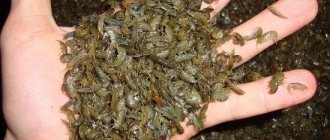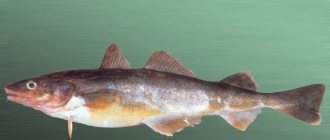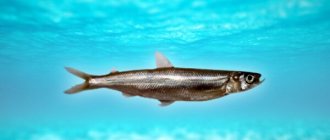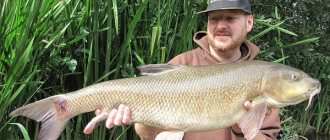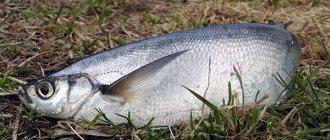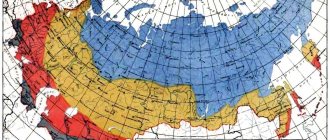Biting calendar
| January | February | March | April | May | June |
| — | — | + | +++ | + | +++ |
| July | August | September | October | November | December |
| +++ | +++ | + | + | — | — |
Seasonal fishing
| Chekhon can be caught from early spring until freeze-up. The most active bite is observed before spawning (which usually occurs in May), when the fish gather in large schools and greedily grab the bait. During the spawning period, the bite stops, and after 2 weeks it resumes. |
| In summer, the bite is not stable; the fish usually become active before rain or thunderstorms. |
| In the fall, successful fishing occurs when fish move en masse to their winter camps. |
Features of catching sabrefish
- From the shore and from the boat. If hunting for saberfish is done from the shore, it is important to take precautions, camouflage, and fishing together is doomed to failure. But this fish is quite careful, even with good camouflage, it becomes wary and moves to a safe distance, and this is the length of the rod plus the fishing line. In such situations, a boat will help out.
- Depending on the season. Hunting for saberfish is possible from the earliest spring until the onset of frost. Biting activity is observed before spawning. In summer, there is no particular stability; noticeable shifts are visible before rain or thunderstorms. In the autumn season, a good catch can be obtained during the mass migration of fish to wintering sites. In winter, sabrefish should be looked for at river bends; biting activity is minimal.
Chekhon habitats
Flocks of sabrefish prefer to stay in large rivers and reservoirs; this fish does not enter small rivers. The fish occupy areas of rivers with fast currents and considerable depth. It never enters ilmens, flood lakes and floodplains. Typically, sabrefish are located at the surface of the water during the day, descending to depth only at night. In winter, the fish go into deep holes (up to 15 m) with a weak current. There it occupies the water horizon a meter from the bottom.
Where and when to catch saberfish
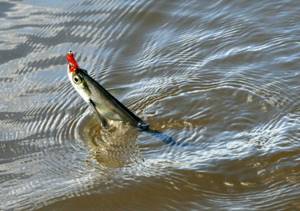
In order for sabrefish fishing to be effective and entertaining, you need to decide on its favorite habitats, and these are deep-water sections of rivers with fast currents. During the day it can be found both at the very surface of the water and in its middle layers.
The spawning period of saber fish begins in May, but for certain climatic zones this period may either be delayed or come a little earlier. Before spawning begins, flocks of sabrefish move up the river, moving against the current. At this time, there is an incredible bite and indiscriminate grabbing of baits. Since sabrefish are a schooling category of aquatic inhabitants, they are caught several at a time; if the bite stops, it means the school has left.
For information: the saberfish’s spawning trail runs along the deepest parts of the reservoir. Individuals try not to approach the coastal zone, except at night. Considering that a school of sabrefish consists of individuals of equal size, therefore fish of equal value will also be caught. Of course, there are also mixed flocks, but this is extremely rare. Having spawned, the flock moves downstream and returns to its original places.
Among the promising places for hunting saberfish are:
- Places near deep holes.
- Boundaries of slow and fast currents.
- Deep-water areas of the reservoir.
- On a fast current.
- In large bays without dense vegetation.
Corsair hunting is carried out in both the upper and middle layers of water. But areas with dense vegetation and shallow waters may not even be considered as catching areas. This fish prefers to feed in deep areas free of any algae.
Towards the end of spring (after spawning) and throughout the summer, saberfish are constantly patrolling the vicinity of a particular reservoir, but at the same time they stay in their camp and do not move far. Based on the observations of experienced fishermen, we can conclude that if a saberfish pecked in one of the sections of the reservoir, then after some time it will return to this place again. Although it is better to choose another suitable place for fishing than to just sit and wait for the school to return (several hours will pass).
Chekhon is a rather cautious fish and does not come close to the shore during the daytime. To increase the chances of a good catch, you need to use long casting. With the onset of night, it can be observed in the coastal zone, on a calm current, under hanging tree branches. You can use bottom gear to catch sabrefish, but only at night, when it goes to the bottom in search of food. Often, at the sight of a sinking bait, a saber fish attacks it while still diving, without waiting for the bait to reach the ground.
The best time for catching sabrefish is considered to be the pre-spawning period, which is mid-April and early May (spawning duration is 3 weeks). The fish is preparing to spawn, its appetite increases, it does not overload with baits, it takes everything that comes into its field of vision. When a large school of sabrefish approaches the chosen location, the angler has the opportunity to catch more than a dozen fish at once.
Chekhon is quite a profitable fish in terms of hunting; it can be caught around the clock. But depending on the air temperature, its activity appears at a certain time:
- For hot summer days this is morning, evening, night.
- For cool autumn days, this is lunch.
Chekhon spawning
The saber fish reaches sexual maturity at 2-3 years in the southern regions, and at 3-4 years in the middle zone. In most rivers and reservoirs, spawning occurs simultaneously. Spawning time begins when the water temperature reaches 12°C. In the middle zone, spawning occurs in May and June. River fish spawn in river beds, staying near the surface. The eggs are gradually carried away by the current and sink to the bottom. In reservoirs and lakes, saberfish spawn near the mouths of streams and rivers, where there is a fairly high concentration of oxygen. The depth in the spawning areas ranges from 1.5 to 6 m. Spawning occurs within 7-10 days.
Fishing on a feeder
In autumn, this type of fishing has some peculiarities. A decrease in water heating causes these fish to move closer to the holes on the bottom surface. But in October, she prefers to be in its middle layers, so when fishing for sabrefish, additional requirements are placed on the tackle, baits and bait used.
First of all, it is necessary to take into account the characteristics of the reservoir where fishing will take place. If you plan to cast bait over a long distance, then choose a rod up to 4 meters or more in length. Its test is also of great importance. If you purchase a form for fishing on the current, then the test value is 150 grams. You also need to pay attention to the structure, because when fishing, the saberfish makes sudden movements and the tackle must absorb them and tire the fish.
Reels are installed in accordance with the size of the fishing rod. When catching this fish, cords or thin fishing lines are not used, so you can purchase a cheap inertia-free option.
Feeders choose light ones so that they sink into the water longer. Chekhon prefers to be in the middle horizons of the reservoir and it is important that the feeder does not fall to the bottom quickly. The best option is its plastic variants, which have a minimum loading weight.
Fixed to the main line and leash. Its length is at least a meter. It will ensure that the hook is gradually immersed in the water, which increases the likelihood of a bite. Most anglers advise installing hooks with long shanks. You can put more bloodworms on them.
Baits and lures
Chekhon is interested in any object that has fallen into the water. But fish don’t bite on every bait.
- In spring, it is preferable to use baits such as dung worms, bloodworms, caddis flies and maggots.
- In summer, fishing is successful with large flies, wasps, gadflies, and grasshoppers. Large sabrefish can be caught using fry. It should not exceed 3.5-4 cm in size.
You can successfully catch large sabrefish using artificial baits: wobblers, twisters, vibrotails, flies.
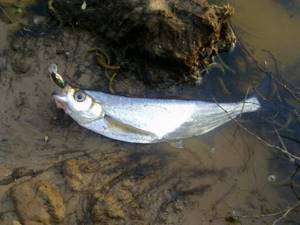
What you need to know about lures and baits?
Chekhon feeds on insect larvae and the insects themselves. In this regard, a worm, grasshopper or large fly is ideal as bait. This fish also bites well on bloodworms and caddisfly larvae. A bait that remains relevant at all times of the year is maggot, which is especially loved by sabrefish. From the end of summer, you can catch this fish using fry or “sandwich”, which is a combination of maggots and bloodworms. During periods when the bite is quite intense, it is not difficult to save a little on bait by giving preference to hominy or pearl barley.
Fishing methods
Elastic band is the most common gear for active fishing of saberfish in schools. Thanks to several hooks in the rig, you can catch 2-4 fish in one approach, depending on the activity and density of the fish.
Feeder fishing allows you to catch sabrefish in the shallows, or in cold weather in early spring or autumn, when sabrefish descend to depth.
Float tackle is one of the simplest and most cost-effective methods of fishing. Especially good gear with the ability to cast long distances is match and Bolognese fishing rods.
Sbirulino is a spinning method of fishing near the surface with a large float, which acts as ballast and allows you to throw even light flies, spinners, twisters or animal baits over long distances.
☸ Attachments
The most popular bait for catching sabrefish is considered to be maggots, strung 3-4 pieces per hook. During the season there are a lot of people who want to catch sabrefish and other fish, and this sometimes causes inconvenience, the main of which is considered to be overlapping gear. The sabrefish usually bites boldly and very confidently, which is hard not to see. However, luck may not always be on the side of the fisherman; in some situations, neither diving to depth nor changing complementary foods helps. But there are periods when sabrefish bite without stopping, and fishing can only be interrupted when the bait runs out.
Therefore, when you decide to go fishing, you need to take:
- more maggots, in case of a good catch,
- spare hooks,
- floats with weights,
- It is advisable not to forget the monofilament spool.
When it bites, you need to hook, but you don’t need to rush to reel it in, but should lead by pulling on the line. Usually the sabrefish does not take it deep, at 2-2.5 meters. Also, if you wish, if you are not in a hurry, you can catch several fish at a time.
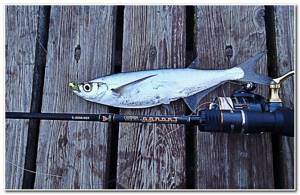
Fishing tackle for sabrefish
When choosing gear for your upcoming fishing for saberfish, pay attention to the following points:
- A fishing rod for fishing should first of all be light, 3.5-4 meters long. The presence of pass rings and an inertia-free reel is required.
- Monofilament fishing line should be used with a diameter of at least 0.18 millimeters. Particular attention should be paid to line spooling to achieve effective long casting.
- The float should be made of high-strength foam, which has two passage rings. Before casting, it must be equipped with a sinker, so that only the tip is visible.
- The top of the float should be painted black if the weather is cloudy or white if it is sunny.
- Despite its small size, the saberfish has a large mouth and opens it wide when biting, so it is best to use good quality and durable hooks for equipping the fishing rod.
☸ Best time to fish
In May-June, spawned sabrefish get sick for some time, migrating upstream to areas of permanent habitat, but then show an incredible appetite. Of course, because she needs to restore the strength spent on spawning and the subsequent struggle with the oncoming water flow. Usually the post-spawning period coincides with the mass emergence of insects, so a hungry saberfish, keen on hunting them, loses its vigilance. Anglers can't wait for this moment, when for just two to three weeks they can truly enjoy exciting fishing.
You can fish with anything, even with such ancient gear as an elastic band. The main thing is to put a heavier load so that the tackle does not drift away with the current, and to guess the fishing location. Experienced fishermen recommend choosing for fishing active sabrefish large shallows located near the riverbed, quiet areas behind sand spits (here it often waits for drowned beetles and other insects carried by the stream), places where the border between the rapids and the slow current passes.
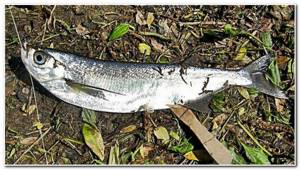
The bite of sabrefish can become noticeably more active when the water level rises, when the river flow washes various small animals off the banks. On such days, she often manifests herself on the surface, chasing various little things that the current carries. Often large individuals also take part in such a feast, so it is advisable to use larger hooks and string three to five larvae or adult insects on them at once.
Where is the saberfish found?
The fish thrives in warm, cold and salty conditions, which allows it to successfully inhabit the sea shelf and freshwater bodies with a wide range of microclimatic differences. The saberfish has a well-developed osmoregulation mechanism, thanks to which lightning-fast adjustment occurs to the excess hydrostatic pressure characteristic of the sea. At the same time, a biosystem for normalizing water-salt metabolism is launched, which rearranges the functioning of the gills, intestines and kidneys for the active removal of excess electrolytes from the body.
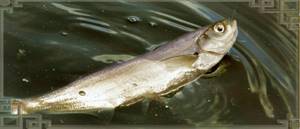
The efficiency of this process is so high that until recently the mower lived in the highly salty Aral Sea. Unfortunately, now the habitat of saberfish in Central Asia has been greatly reduced to the lower reaches of the Syr Darya and Amu Darya and Lake Chelkar (Kazakhstan), which is also characterized by a growing problem of bitter-salty water.
In Russia, saberfish are found in the basins of several seas at once:
- Azovsky - Mokry Elanchik, Don, Eya, Kuban, Mius, Protoka, Sambek, Mokraya Chuburka, Khoper;
- Caspian - Oka, Kama, Volga, Ural, Samur, Sulak, Terek, Akhtuba;
- Cherny - Psou, Shakhe, Mzymta, Sochi, the upper reaches of the Dnieper and partly the Kuban, one of the branches of which flows into the Kiziltash estuary on the Black Sea coast;
- Baltic - Luga, Pregol, Western Dvina, Neman, Svir, Volkhov, Neva, Ilmen, Ladoga and Onega lakes.
It is along the Neva and the Gulf of Finland that the northern border of the habitat of saberfish runs. In the east, such a limiter is the left-bank tributaries of the Urals, for example, the Ilek and Or. In the west - Lake Peipsi, the upper reaches of the Narva, Western Dvina, Dnieper and Desna.
Where to catch sabrefish in the Moscow region
Rivers and reservoirs in the immediate vicinity of the capital can also boast of the presence of this fish. The most numerous saberfish are in the Oka, Canal named after. Moscow, Pyalovsky and Pestovsky, Ivankovsky reservoirs. Here the fish stay far from the shore at great depths, so to successfully catch them it is advisable to use a boat or long-range tackle, such as a spinning rod for jigging.
Chekhon nutrition
Chekhon feeds all year round, taking a short break only during the spawning period. As it develops, its taste qualities change.
The feeding characteristics of saberfish contain the following patterns:
- Chekhon larvae eat small animals or so-called zooplankton that live in water: small crustaceans, shrimp, rotifers, etc.
- A little later, the sabrefish already eats other food, in particular: sprat, roach, verkhovka, gudgeon, insect larvae, adult insects.
- During spawning, saberfish eats practically nothing, but after this period it feeds very actively.
- In winter, when there is severe frost, saberfish may also stop drinking for a while.
- Chekhon eats most actively in the morning and in the evening. However, it is not a shy fish and quickly attacks the intended food, be it an insect or a fish. After feeding, she goes into the depths, but after some time she again joins her flock from behind or from the side, looking for her next victim.
- Sometimes she eats at night, but this doesn't happen often.
- Chekhon also does not refuse mollusks, worms and freshwater fish meat.
What does saberfish eat?
The diet of fish is quite diverse and is determined by its age, size and habitat. Very small individuals eat zooplankton, which is dominated by tiny crustaceans, larvae, worms, and leeches. Adult saberfish significantly expands its menu, additionally including:
- large winged insects;
- Smooth mosquitoes, combing mosquitoes, bell mosquitoes;
- stoneflies, water burros, coridals;
- juveniles of other fish (minnow, bleak, roach, dace, crucian carp, rudd).
The hunt of sabrefish for fry looks interesting and unusual: it attaches itself to the flock and moves with it for some time, without demonstrating any aggression. Then there is an imperceptible grab of the nearest victim and a sharp departure with it to the depths. After a few minutes, the fish returns and repeats its trick.
